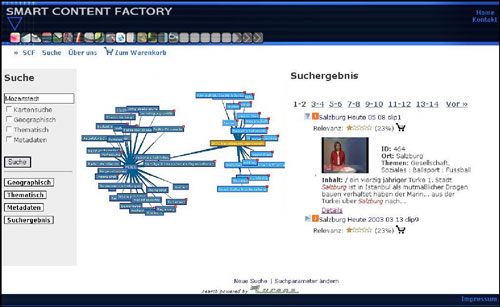Towards a 'Smart Content Factory'
by Georg Güntner
A project at Salzburg NewMediaLab (SNML) introduces a pragmatic approach to the implementation of a knowledge-based infrastructure for search and retrieval in audiovisual repositories.
While the consumer market provides us with increasing possibilities to create rich media content (cameras, smart phones etc), the ‘professional’ content industries (broadcasters, news agencies etc) continue to digitize their complete content life-cycle management processes. This results in a semantic gap between the ease of content creation and the need for the utilization of content in a context-aware, individually tailored way.
The Smart Content Factory
In October 2003 a group of Austrian technology and science partners (X-Art ProDivision, ORF, Joanneum Research, coordinator: Salzburg Research) started a project entitled ‘Smart Content Factory’ (the Factory). The project aims to develop a knowledge-based infrastructure for search and retrieval in an audiovisual archive: The approach of the project is not to reinvent existing media management technology, but to create a framework superimposing a ‘semantic layer’ on top of state-of-the-art technology. The general objective of the project is to define a system architecture supporting a wide range of ‘knowledge-intensive’ user scenarios for the utilization of rich media content in the business to business (B2B) and business to consumer (B2C) areas.
The project is one of the lead projects at Salzburg NewMediaLab (SNML), the Austrian research centre in the area of digital content engineering.
Objectives and Results
This section outlines the project objectives and shows the approach the project team took during the prototype phase to meet the requirements.
Re-use of existing content:
By using content 'as is' there is no need to reformat or transform existing content into new data structures. Hence there is no need for redundancy of high-volume data storage. All operations related to the media clips use unique references to the media objects.
Aspects of integration:
The Factory’s indexing components offer interfaces for integration into the content production workflow. For example, when a new digital video editing system is introduced, the Factory will be informed of newly created content and the indexing process will be triggered as soon as new content is published. Currently the Factory supports an indexing pipeline consisting of two steps: a primary content-based indexing and a secondary semantic indexing using the concepts of the know-ledge base.
Interoperability:
The Factory makes use of state-of-the-art digital asset management technology. Wherever possible, standard-based interface layers are used to keep the core of the Factory independent of the underlying data and knowledge layer. The Factory uses Virage’s VS Archive™, a media management system offering powerful content-based indexing features and a well documented programming interface. In the course of the project an MPEG-7 interface was created to avoid dependencies from the proprietary system.
Adaptability and extensibility:
The Factory will be adaptable and extensible to various domain knowledge models. Currently three ‘pluggable’ knowledge models form the knowledge base of the Smart Content Factory: (i) the ‘Geoname Thesaurus’ developed by Salzburg Research; (ii) the IPTC thesaurus provided by the International Press and Telecommunications Council; and (iii) a service of (German) synonyms provided by the University of Leipzig. The first two of these are represented in RDF according to the SKOS Core Meta Model (W3C).
Usability:
The Factory makes use of advanced user interface paradigms for easy exploration and navigation in the repository, including reasoning and recommendations. In the prototype, hyperbolic tree navigation (based on TouchGraph) is offered for browsing the knowledge models. The detailed result view (‘video summary’) offers a synchronized presentation of the video-, audio-, speech-, keyframe- and stripe image-track.
Outlook
The project has now delivered a first vertical prototype for a knowledge-based search and retrieval scenario in an audiovisual archive. Future work will be dedicated to the extension of the core infrastructure to the needs of other 'knowledge-intensive' scenarios, such as the automatic creation of a summary of historical video clips related to a certain event or person. We therefore plan to integrate additional knowledge models (eg temporal categories and categories related to Austrian history and policy), and to adapt the content retrieval methods to the user’s intuitive understanding of 'generalization' and 'specialization' (using inferencing and reasoning based on the knowledge models).
The prototype has shown that our approach to integrating and extending existing technology with semantic features has proven feasible. However complex it seems to implement a fully featured, knowledge-based infrastructure for audiovisual repositories (and some earlier projects got lost in this complexity), one must start with manageable and pragmatic steps to approach the vision of a 'Smart Content Factory'.
Links:
http://www.newmedialab.at/
http://www.iptc.org/
http://www.touchgraph.com/
http://www.virage.com/
http://www.w3.org/2004/02/skos/
Please contact:
Georg Güntner, Salzburg NewMediaLab, Austria
Tel: +43 662 2288 400
E-mail: georg.guentner newmedialab.at
newmedialab.at



